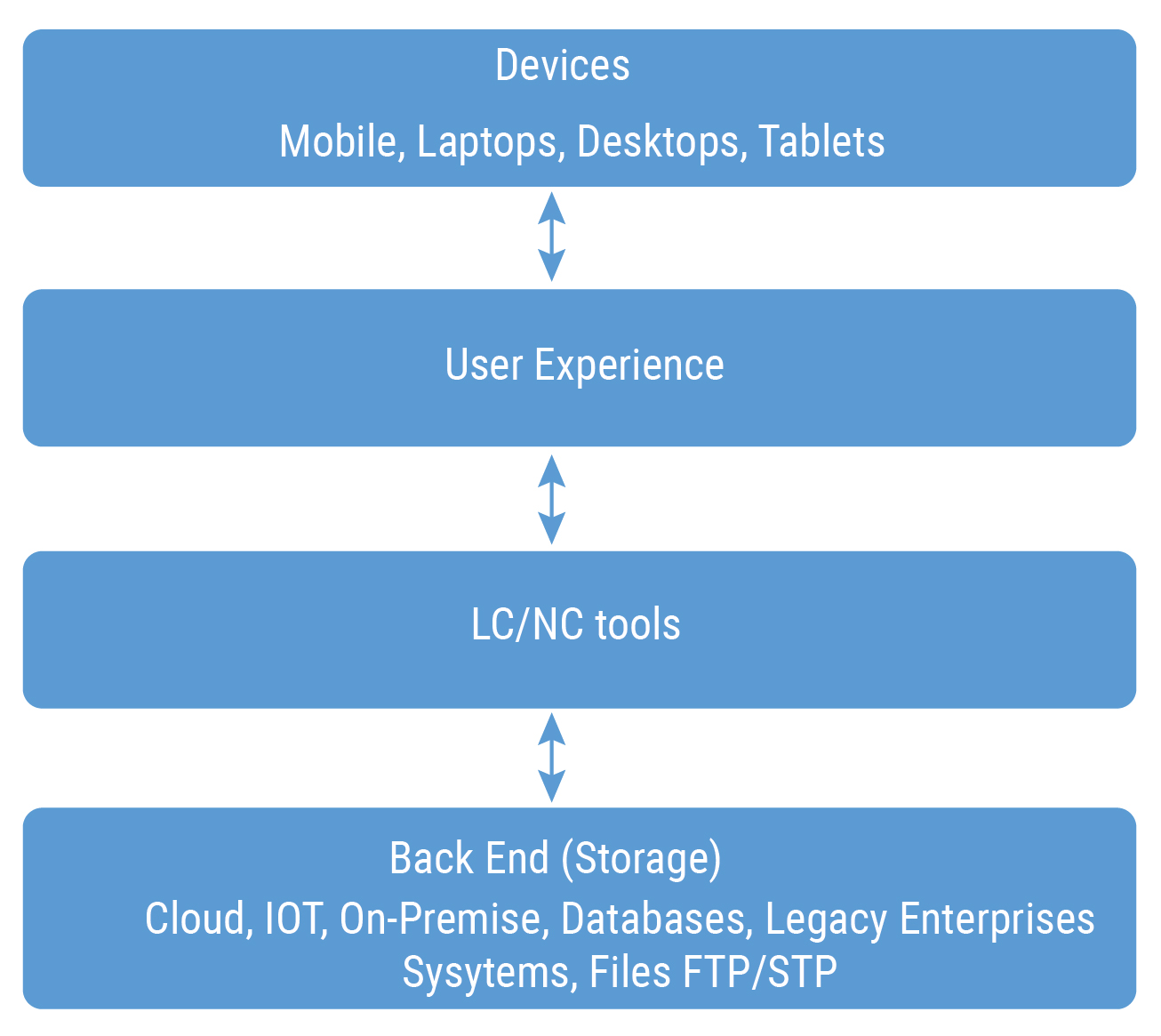
All-In-One Scriptless Test Automation Solution!
All-In-One Scriptless Test Automation Solution!
Gartner says “Low-code development tools promise success in application democratization, workflow automation and composite development. Software engineering leaders should use this research to understand the low-code development tool landscape, and evaluate solutions that meet their strategic and tactical needs.”
Businesses worldwide started to adopt automation and reduce human intervention in many resource and time-consuming processes because of the global economic crisis and remote working situations. The exposure of low-code or no-code towards software development is increasing as it allows the organizations to maintain the fast-changing technology landscape. Moreover, almost every IT sector adopts the low-code/no-code technology to locate itself in the emerging no-code space.
Low code development accelerates the digital transformations and creates new opportunities for small to large-sized businesses. The digital wave also boosts the production of the application development and reduces the release cycles. The enhancement in the automation of business processes with Artificial Intelligence(AI) paves the way to achieve digital innovation much faster and easier. No-code platforms allow business leaders to develop apps and dashboards to automate and simplify many business-critical processes.
The integration of low code platforms with programming tools that automate the application deployment is much easier. Also, they can help in some of the crucial processes in any DevOps culture that includes version control, build validation, and Quality Assurance(QA). The no or low code can reduce the overall complexity and improves the speed of DevOps teams simultaneously. The application’s deployment happens in a conventional manner, which frees the developers from worrying about the compatibility and efficiency. The low-code/No-code platform easily gets integrated with the enterprise’s workflow without any risks makes the teams confident. DevOps brings development and operations together, whereas Low-code/no-code development platforms possess the capabilities that can reduce workloads and offer more automation into the DevOps process.
The objective of adopting DevOps within an organization is to minimize the tedious manual tasks that engage developers’ time and lead to app delivery discrepancies. The solutions that streamline and reduce DevOps’ workload through automation and low-code development platforms are becoming more pivotal and in-demand.
The low-code app development platforms can improve the growing role of DevOps by
The product team should be aware that low-code development technologies encapsulate a range of software development functionalities. It brings the technology and processes together that draw developers who do not have much skill set in software development.
The success of cloud computing has highly improvised the emergence of the business process to increase automation. When organizations implement business process automation, they free themselves and their employees from tedious tasks.
Many CIOs are attracted to the evolving technology practice known as Robotic Process Automation (RPA) to organize enterprise operations and minimize costs. With RPA, organizations can automate tire-some stringent business processes, allowing business users to invest more time helping customers or other important work.
The LCAPs include high-throughput PaaS applications, Rapid Application Development (RAD), and (Rapid Mobile App Development) RMAD tools. Faster application development, deployment, and delivery is the primary goal of LCAPs. It minimizes the traditional coding, enabling rapid delivery of business applications through low-code tools.
(MXDPs) help organizations scale their applications spanning various devices and platforms. They can help you build a single application and deploy it on multiple devices, which in turn lessens your efforts and provides companies more control over their digital experiences. Low-code is one of the features on these platforms, but it also supports IDEs such as JavaScript or XML.
Although software developers have proficiency in developing apps with complex Code, the low code/no-code software can help them work faster and reduce mundane tasks.
They also can minimize developers’ work, time allowing them to design, test, and deploy tools faster. These platforms reduce development time by allowing developers to skip redundant and automate technical tasks.
Low-code/No-code platforms are mainly preferred to automate the manual processes and increase accuracy and quality by reducing costs. It makes it easy to build applications for capturing information and include ready-made connectors for integrating applications into core systems. Most of the platforms include workflow automation.
One of the best capabilities of Low or No code solutions is innovation. It allows the industry leaders who understand emerging technologies such as the Internet of Things (IoT), artificial intelligence (AI), machine learning, blockchain, and legacy systems to innovate in a better way. The learn and discover approach allows users to create functional prototypes and iterate towards fully functional applications.
Low or No code platforms enable rapid development of customized applications via connectors or building middle layers.
This leads to easy integration with legacy applications to create end-to-end products. Companies can use Low or No code tools as strategic solutions to integrate various components in the long term.
An individual with a basic skill set is enough to drive the No-code/Low-code platform and build applications efficiently.
The configuration is quicker than writing, debugging, and compiling, which allows the teams to create end-user functionalities faster.
Low or No code platforms improve the speed with digital transformation. When you’re developing applications with a no-code platform, you don’t have to focus on the coding rules for scalability, which boosts the process’s speed.
It supports metadata versioning for any changes made to applications, proper agile development, and change management, as you can revert a change with a single click. This option builds confidence, and the business can roll out changes rapidly after fundamental Testing.
Most of the application development is done through a drag-and-drop interface with pre-built modules. Usually, Testing is automated, which further reduces the development time.
Low code/no code optimizes the business processes since apps can be built at a much faster pace, thereby increases productivity.
Low code development tools bring numerous benefits, such as high productivity, reduced cost as it develops more applications in lesser time, and more individuals can contribute to the application development process. Also, these platforms help enterprises in enhancing their agility. It minimizes the complexity of the application development process. For Example, the low code platform Liferay lets you build your enterprise website and customize it according to the business’s needs. It supports all the languages such as C++, Java, PHP, .NET. You don’t need to code to use this tool. You can create highly robust websites without having to write even a single line of code.
No-code or Low code platforms are the best fit for businesses that have limited IT resources. Sun Technologies uses an agile development approach and helps enterprises build strategic business objectives and establish the business workflow. Our experts put the right system architecture in place to deliver efficient and high-quality products. We use good change management practices and minimum standards to boost the development process and build top-notch products.
Our No-code approach with Artificial Intelligence (AI) in the development and testing phase helps business users automate those redundant and error-prone processes. Sun Technologies IntelliSWAUT, an AI-powered scriptless test automation solution, helps enterprises transform operations, enhance product quality, and reduce time to market. Success with no-code or low-code is ensured with our ideal approach to integrating automation with data and intelligent application development.

Presently, no code/low code platforms/systems are already using AI bots to verify software code and automate test functions. As your teams discuss the tech enablement of your organization’s product or service, it will be increasingly crucial for them to understand the capabilities that speed up software development using techniques with no code / low code development.
At Sun Technologies, our expert no code team can help you with any of the no-code or low code platforms that fit your company’s requirements. We know what suite of tools to use for any project and how to use them. We help your team get the best ROI on these products!
No. No-code tools will never replace developers. No-code tools empower the developers from all domains to get started developing software. It helps reduce the technical hurdles to entry for those without any previous specialized experience. So, no-code tools don’t remove developers from the industry. Instead, they help empower the team to build better products quickly.
Modern no-code tools can scale up applications/products without ever needing to touch a line of code which opens up vast opportunities for the future of no-code.
Low-code tools eliminate risks from developing high-quality modern business apps. Minimized complexity bears seamless results. With the benefits of low-code tools, companies quickly adapt and respond to rapid-changing business scenarios.
Outsystems, Appian, Mendix, and Kissflow are some of the most popular low-code platforms in the market. IntelliSWAUT is one of the emerging, and most promised scriptless test automation tool enterprises are opting for.

With over 18+ years of experience in Software design and development, Tahir's expertise lies in designing and developing high-quality products and solutions spanning multiple domains. He is versatile and always eager to tackle new problems by constantly researching and deploying emerging techniques, technologies, and applications.
Looking for a solution to achieve greater ROI?
We deliver result-driven solutions to boost the competency level and productivity.